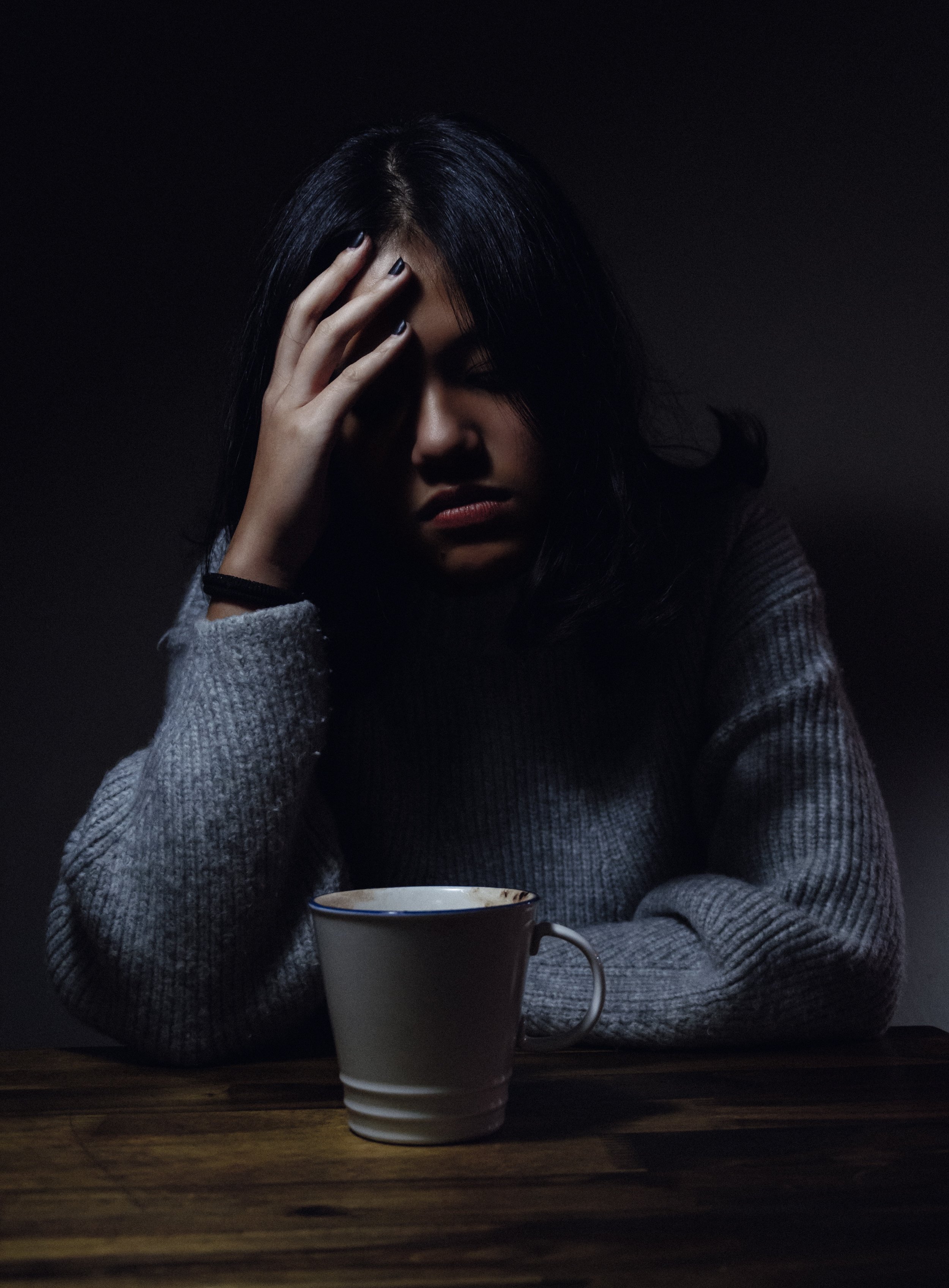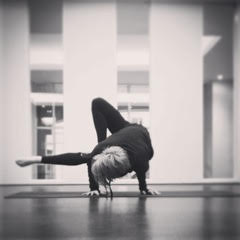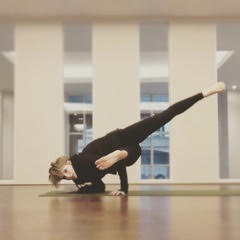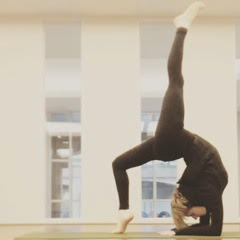Most of us recognise those achey, crunchy, tight and weak feelings we often get during or after a long journey. Whether it's cramped behind the wheel of a car, squished into an airplane seat with little to no legroom, or hanging around on the hard seats of waiting rooms and departure lounges, sometimes all you can hope for is a little relief. Well, why not try a few of these Pilates Exercises, (all of which can be performed seated!) and see how you feel…
Viewing entries in
Fitness
by Candice Habershon
Candice teaches Vinyasa Flow on Tuesday & Friday mornings at 9.30am, and is running a Winter Wellness Workshop this Saturday 24th November. Book your spot via our Events Page!
Winter can be a trying time both mentally and physically. The days are darker, colder and shorter and our bodies become more susceptible to all kinds of nasties like colds and flu. Top all that off with the stress of the silly season in the run up to Christmas and it might become tempting to stay inside and hide away from it all. Being proactive at this time of year will help ensure you stay calm, happy and well. Below, Candice offers her top tips to supercharge your winter wellness.
Keep moving
Make sure you’re getting at least 30 minutes of moderate exercise a day that raises your heart rate. Research has shown that increasing your heart rate could help to speed up the circulation of white blood cells in the body, making it more likely they will seek and destroy germs early on. Just be careful not to overdo it as that will have the opposite effect.
Open your heart
It’s our natural instinct in cold weather to hunch our shoulders. But at this time of year we should be actively doing the opposite. Heart-opening poses such as sphinx, cobra, fish and bridge pose stimulate blood flow to the thymus an organ situated behind the breast bone that is instrumental in the growth of germ-killing T-cells.
Let’s twist again
Twists are brilliant at helping the body deal with stress or anxiety – two emotions that tend to surface at this busy time of year. Opening the chest, shoulders and back through twisting can help to release stored tension in the body, leaving you feeling calmer mentally.
Get upside down
Because inversions increase the flow of blood moving toward the heart, the heart doesn’t have to work as hard to circulate oxygenated blood properly throughout the body. Inversions are also great for moving lymph around the body strengthening the immune system.
Strike a (warrior) pose.
Grounding poses, like warrior 1 and 2, help to calm the frenetic vata energy of this season, and gives us durability and stability through the winter. They develop concentration, balance and groundedness and help to energise the entire body.
Create an internal fire
Ujjayi breath, where you exhale through the nose using a slight restriction at the back of the throat, helps to generate internal body heat. This form of pranayama, or breathing exercise, can help to alleviate headaches, relieve sinus pressure, decrease the production of phlegm, and strengthen the nervous and digestive systems.
Spice up your life
Make sure you pop these immune boosting spices into your shopping trolley this month
Turmeric - beneficial for its antiviral and antibacterial properties.
Ginger – stimulates digestion, boosts immunity and alleviates coughs and congestion.
Cinnamon – great for drying up runny noses
Black pepper - revitalises circulation, respiration and digestion.
Use oils
Winter is cold and windy so in ayurvedic practices it is known as the vata time of year. Massaging oil into the skin after a bath or rubbing some into the feet before bedtime is a great antidote. Lavender or clary sage are both excellent for calming vata.
Meditate
Running around trying to get things sorted for Christmas affects your body’s ability to fight germs. Studies have shown that meditating helps to reduce the levels of stress hormones in the body, slows the heart rate and decreases blood pressure. At the same time, resources that were directed to support fighting or running are now directed to support healing and immune system functions.
Have fun
Plan a date with friends, book a movie or enrol in a pottery class. Studies have shown that looking forward to an event boosts immunity, while loneliness can have the opposite effect. If you’d rather be at home, get a friend to come over and watch a comedy with you. It’s true what they say about laughter being the best medicine: not only does it boost the immune system, it protects the heart and burns calories too.
Want to find out more?
Come along to Candice’s Winter Wellness Workshop at the Honor Oak Wellness Rooms at 1:30pm this Saturday 24 November. Just a few spaces left!
by Tatjana Gretschmann
Appointments are available with Tatjana at the Honor Oak Wellness Rooms on Friday mornings or by arrangement only.
What is a Migraine?
Migraine is a neural condition which is characterised by recurring headaches which usually last between 4 to 72 hours where the pain ranges from a moderate to a severe intensity. A migraine attack may be accompanied by nausea, noise sensitivity, and photophobia, sometimes preceded by sensory disturbances (aura). Triggers of migraine episodes vary widely and may include routine physical activity, allergic reactions, diet, alcohol, and bright lights. Migraines can have a serious effect on a person’s quality of life, affecting productivity and draining happiness and well-being. Research shows that more than 70% of migraine sufferers experience impairment in interpersonal and work relationships, and that anxiety and depression are significantly more common in people with migraine than in healthy individuals.
Who Suffers from Migraines?
Migraines are very common. According to the Migraine Trust, migraine is the third most common disease in the world, affecting about one in seven people. More than three quarters of sufferers experience at least one attack each month, and more than half experience severe impairment during attacks. It often starts at puberty and most affects those aged between 35 and 45 years, but it can trouble much younger people including children.
Are Migraines Hormonal?
Chronic migraine affects three-times as many women as men, this higher rate being most likely hormonally-driven. It has long been recognised that some women are more sensitive to hormonal fluctuations within the menstrual cycle and around 50% of women find that their migraine attacks are linked to their periods. The perimenopause can also be a difficult time for women who suffer with migraines as the irregularity of periods makes is it more difficult to predict. Some women will experience more frequent and severe attacks than before the perimenopause while others will find that their attacks continue to follow a cyclical pattern years after their last period and the onset of menopause. Menopausal issues, such as hot flushes and night sweats, result in disturbed sleep, add to stress levels and therefore also increase the likelihood of an attack.
What is Acupuncture?
Acupuncture is a therapy in which thin sterile needles are inserted into the skin at particular points. It originated in China and is now used in many countries to treat people with a wide range of conditions, including migraine. It is considered a very safe treatment when practiced by a fully qualified traditional acupuncturist.
How Can Acupuncture Help with Migraines?
Many people with migraine can be treated when their attacks occur, but some need prophylactic interventions as their attacks are either too frequent or are insufficiently controlled. However the drugs that are used in an attempt to reduce the attack frequency, (such as betablockers, amitriptyline or sodium valproate) are associated with negative side effects.
Acupuncture can help in the treatment of migraine by:
Providing pain relief, by stimulating nerves located in muscles and other tissues, leading to a release of endorphins and other factors thus changing the processing of pain in the brain and spinal cord.
Reducing inflammation, by promoting release of vascular and immunomodulatory factors.
Reducing the degree of cortical spreading depression, an electrical wave in the brain associated with migraine.
Modulating extracranial and intracranial blood flow.
Affecting serotonin levels, in the brain. Serotonin may be linked both to the initiation of migraines and to the relief of acute attacks.
Increasing local microcirculation, thus aiding the dispersal of swelling.
Does It Work?
There is a large body of evidence to suggest that acupuncture is effective in the treatment of migraine. Research has found that adding acupuncture to symptomatic treatment of attacks reduces the frequency of headaches, with trials suggesting that acupuncture may be at least similarly effective as treatment with prophylactic drugs.
The National Institute for Care and Excellence (NICE) recommends that patients are offered a course of up to 10 sessions of acupuncture as a treatment to prevent migraine if neither topiramate nor propranolol, which are commonly used as migraine prophylaxis, work well.
Can I Book a Session?
Yes you can! Tatjana (author of this blog) offers Acupunture appointments at the Honor Oak Wellness Rooms on Friday mornings, or by arrangement. You can book online, or contact the clinic to make an appointment.
--------------
References
British Acupuncture Council (www.acupuncture.org.uk)
Migraine Trust (www.migrainetrust.org)
Cochrane (www.cochrane.org)
The National Institute for Care and Excellence (www.nice.org.uk)
IF YOU WOULD LIKE TO ACHIEVE GOOD POSTURE – START WITH YOUR PELVIS
by Roisin Woodford
WHAT IS THE PELVIS FOR?
The basin-shaped structure at your body’s centre is responsible for supporting the weight of your trunk and head above as well as transferring the weight to your legs below. It also receives stresses from your legs during movement. You could say that the position of your pelvis is pivotal to whether you have good or faulty posture.
HOW DOES THE PELVIS AFFECT ALIGNMENT?
Your pelvis connects to your spine via the sacrum (the lower part of your spine made up of 5 fused vertebrae) and to the legs via the hip joints. Neutral alignment of the pelvis is the most balanced position for the pelvis to be in relation to spine and hip joints. It encourages your lower back to retain its natural curve and it is the best position for shock absorption. It also provides a good foundation for efficient movement patterns. Ideally, we want to be able to achieve neutral alignment of the pelvis and to be able to move freely in and out of neutral without holding it fixed.
HOW DOES THE PELVIS MOVE?
The fused bones of the pelvis move as one unit and they can move through neutral to a posterior pelvic tilt which flattens the arch in the lower back and in the opposite direction to an anterior pelvic tilt which increases the arch in the lower back. The pelvis can tilt from side to side and rotate clockwise or anti-clockwise.
PAIN AND RESTRICTED MOVEMENT IN THE PELVIS
All of these movements directly affect the spine in some way and in everyday movement there will be a combination of pelvic positions. However, if any of these positions are held for long periods this may lead to muscle imbalances and a loss of the natural curves of the spine reducing the spines shock absorbing abilities.
Pain and injury can set in in the spine, pelvis and lower limbs due to stress and strain on the body’s supporting structures.
HOW CAN PILATES HELP?
We want the pelvis, spine, shoulders and head to be stable and controlled against any unwanted movement, to provide a base from which the arms and legs can move. We call this ‘Core Stability’. Pilates teaches good alignment of the pelvis and spine so that you are able to move with ease through your daily movement patterns. Tight muscles are lengthened and weak muscles are strengthened, encouraging muscles to work in balance. Emphasis is placed on the deep stabilising muscles of the core, consciously engaging them to increase lumbo-pelvic stability. Imagine wearing a wide belt or corset: muscles that control the pelvis are balanced at the front, back and sides.
Many professional athletes use Pilates to increase their athletic performance, address muscular imbalances caused by the repetitive movement required by their sport and to protect against injury. In contrast, many desk workers with back issues use Pilates to mobilise their back and strengthen their core to manage their various back complaints.
SOUND GOOD?
If you would like to explore the ideas discussed in this post, such as learning to connect to your deep core muscles, how to align your pelvis for good posture, establishing healthy movement patterns and strengthening and lengthening muscles to create balance, then it’s time to
BOOK YOUR SPOT in our Strong Core; Happy Hips Pilates Workshop
This weekend with Roisin Woodford (author).
Saturday 27th October 2018 from 1.30pm - 3.30pm.
References and Sources
1. Calais-Germain, B., Anatomy of Movement. US: Eastland Press, 2008.
2. Kendall, F. P., Muscle Testing and Function with Posture and Pain, US: LWW, 2005.
3. Stott Pilates Training manual
4. Isacowitz, R., Clippinger, K., Pilates Anatomy. Human Kinetics, 2011.
5. Paterson, J., Teaching Pilates for Postural faults and injury: Elsevier Ltd, 2009.
6. Robinson, L., Bradshaw, L., Gardner, N., The Pilates Bible. Kyle Cathie Ltd 2009.
by Lynne Fugard
As forward-facing animals it’s not surprising that we humans get overly concerned with what’s in front of us. As a consequence, a lot of our daily routines and exercise regimens can become restricted to very linear, one-directional patterns of movement, creating imbalanced and uncomfortable habits of tension and weakness in our bodies.
Days spent hunched over a desk, phone, or steering wheel; carrying heavy bags or children; driving, walking, running or cycling; always going forwards, forwards, forwards… It all has the effect of closing up the front of the body, tightening the muscles of the chest, shoulders, waist and legs, whilst weakening the muscles of the back: those bigger muscles either side of the spine, but also the tiny postural muscles that provide vital support and mobility within the spine itself.
As these patterns and habits become ingrained, it becomes impossible to fully realize the healthy range of mobility that should be available to us. Muscle pairs can become imbalanced – some increasingly tight and tense, whilst others weaken and fail to switch on. These sorts of imbalances can potentially even pull the skeleton itself out of natural alignment. The normal, neutral curvature of the spine becomes exaggerated, resulting in an excessive rounding in the upper back (kyphosis), or over-concaving in the lower back (lordosis). We feel hunched over, tired, stressed and tense, and over time chronic pain in the neck, shoulders or lower back can result.
How Can Yoga Help?
One of the joys of a regular yoga practice is the transformational rediscovery of our deep-seated potential for multifaceted motion. We have a spine that can maneuver 360 degrees through 3 planes of alignment - not only forwards and backwards, but also from side to side, in rotational twists, and then through all sorts of combinations of those movements. The yoga practice flows through all of these planes, exploring a healthy range of mobility in each limb, whilst also working to balance and enhance a strong, supple, interconnected musculature that supports and allows such motion to feel safe and stable.
Which Poses Should I Use?
In particular, the yoga poses that most obviously break with linear, forward-facing patterns are twists, side-bends and back-bends. In my classes, I incorporate these movements to mindfully explore the space above and behind us, encouraging new perspectives and creative ways of moving, strengthening around the spine, enhancing posture and breath-capacity, and all whilst brightening the mood, stimulating the nervous system, and clarifying the mind. Suddenly the body feels more alive, supple and buoyant, you wake up every morning more comfortable and spacious, and you begin to challenge your preconceptions about what is possible and maybe even what is normal!
Sound good?
Then it’s time to BOOK YOUR SPOT in our Yoga Improvers: Explore From Your Core! workshop this weekend!
We will build through an invigorating sequence in preparation for the body to weave itself into deliciously deep twists, binds, back-bends and beyond. Whilst opening the shoulders, chest, and side body, we will also cultivate a strong and powerful core, the centre, from which and around which we can move, expand and explore our natural range of motion with intention and curiosity. Using props and partner-work there will be time to break down and work towards those more challenging twists, binds and backbends from the yoga asana practice - including standing, seated, balancing and inverted poses - leaving you plenty of ideas to take back to your self-practice, weekly classes and daily life.
One of the special things about the practice of Tai Chi is the relationship between movement and breath. Over time and with consistent practice, the breathing is maintained in a deep and steady rate, even when the exercise is quite vigorous. This combination of deep and slow breathing while exercising is unusual and gives the combined benefits of exercise and meditation...
Flowing forms of yoga have long been popular in London, with Vinyasa Yoga and all of its affiliates becoming a go-to favourite at most yoga studios and gyms. But beyond offering an invigorating physical challenge, I believe there are more esoteric benefits to this fluid form of yoga that are worth exploring for those of us wishing to deepen our practice...
Road, hybrid, single speed (really, with South London’s infamous hills?), Boris… whatever your ride of choice, whether you compete or commute, there is no denying that cycling is one of the best modes of transport around. It certainly beats cramming yourself into someone’s armpit on a hot, sweaty Tube...
Are your neck and shoulders always tight? Or is your lower back aching? This could be down to a poor posture. Elina Karimaa - our STOTT Pilates teacher explains...
Aquino Alexander, one of our experienced massage therapists explains how a good Deep Tissue massage can be good for your muscle flexibility...
You can flex, but can you bend? Hayley Cotter explains why it's beneficial to balance your Gym routine with some stretching, and even - dare we say it - Yoga!
Karma Yoga in Action Let us introduce you to The Mindful Movement Project; beginning at The Honor Oak Wellness Rooms in April as a monthly charity yoga class to raise awareness of mental health and raise funds for its treatment and research.
We asked Fern Ross, founder of The Mindful Movement Project to tell us a little more about it:
At your desk from 9-5? Office life: it’s more dangerous than you think. As you frantically hammer away at your keyboard, trying your best to meeting looming deadlines, you’re putting your health at risk from all kinds of ailments...
What does this year have in store? Most of us start the New Year setting new years resolutions and we reached out to find out what resolutions our team have set for themselves...
The treatment and prevention of sports injuries
By Simon Leung.
The Rio Olympics have arrived! Have you been as glued to your TV as we have?
Tips For Life After Birth
Our Pilates teacher Eleni Molida McEwan says it like it is; when you're pregnant all your thoughts, wishes and energy focus on having your baby safely delivered to the world. It’s likely that you’ve done your research...
Squats and lunges are some of the best exercises you can do (we think so, anyway!) Our videos in this blog post demonstrates the proper technique.

























